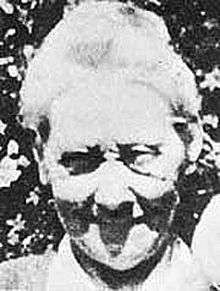Helen Bannerman
Helen Brodie Cowan Bannerman (née Watson; 25 February 1862 in Edinburgh – 13 October 1946 in Edinburgh), was a Scottish author of children's books. She is best known for her first book, Little Black Sambo (1899).
Helen Bannerman | |
|---|---|
 Helen Bannerman | |
| Born | February 25, 1862 Edinburgh |
| Died | October 13, 1946 (aged 84) Edinburgh |
| Resting place | Grange Cemetery |
| Occupation | Author |
| Nationality | Scottish |
| Education | University of St. Andrews |
| Genre | Children's books |
| Notable works | Little Black Sambo |
| Spouse | William Burney Bannerman |
| Children | 4 |
| Relatives | Patrick Heron Watson |
Life

Bannerman was born at 16 Hope Street off Charlotte Square in Edinburgh at the home of her paternal uncle, Patrick Heron Watson.[1] She was the eldest daughter and fourth child of seven children of Robert Boog Watson (1823-1910), minister of the Free Church of Scotland and malacologist, and his wife Janet (1831-1912), daughter of Helen Brodie and the papermaker and philanthropist Alexander Cowan.[2] They spent much time with their maternal aunt, Mrs Cowan at 35 Royal Terrace on Calton Hill.[3]
Because women were not admitted into British universities, she sat external examinations set by the University of St. Andrews, attaining the qualification of Lady Literate in Arts (LLA) in 1887. She then married Dr William Burney Bannerman, a physician and an officer in the Indian Medical Service (IMS). The couple then moved to India, taking up residence in Madras (modern-day Chennai),[4] capital of the state of Tamil Nadu on the southeastern seacoast, populated mostly by the Tamil ethnic group. During their 30 years in India they had four children: daughters Janet (b. 1893) and Day (b. 1896), and sons James "Pat" Patrick (b.1900) and Robert (b. 1902).
She died in Edinburgh in 1946 of cerebral thrombosis. She is buried with her husband in Grange Cemetery in south Edinburgh.
She was the grandmother of the physicist Tom Kibble, who discovered the Higgs–Kibble mechanism and the Higgs boson.
Works
The illustrations and settings of Bannerman's books are all about Indians and their culture. Little Black Sambo has ghee, tigers, and a bazaar, The Story of Little Black Mingo has jungle, a mugger (a kind of crocodile), a dhobi, and a mongoose, Little Black Quasha has a bazaar and tigers, and The Story of Little Black Quibba has mangoes and elephants.
Works
- The Story of Little Black Sambo, 1899[5][6]
- Story of Little Black Mingo, 1901
- The Story of Little Black Quibba, 1902[7]
- Little Degchie-Head: An Awful Warning to Bad Babas, 1903
- Little Kettle-Head, 1904
- Pat and the Spider, 1905
- The Story of the Teasing Monkey, 1907
- Little Black Quasha, 1908
- Story of Little Black Bobtail, 1909
- Sambo and the Twins, 1936
See also
Notes
- Edinburgh Street Directory 1862
- Rootsweb, Helen Brodie Cowan Watson
- Edinburgh Post Office Directory 1862
- Jeyathurai, Dashini. "The complicated racial politics of Little Black Sambo", South Asian American Digital Archive, 4 April 2012
- Stories for Little Children, p. 376 (1920) Houghton Mifflin, New York
- Mary Stone, ed. (1908) Children's Stories that Never Grow Old, p. 173, Reilly & Britton Company, Chicago
- Helen Bannerman (1902) The Story of Little Black Quibba
References
- Hay, Elizabeth (1981), Sambo Sahib: the story of Little Black Sambo and Helen Bannerman (1st ed.), Edinburgh: Paul Harris Publishing, ISBN 0-904505-91-X
External links
![]()